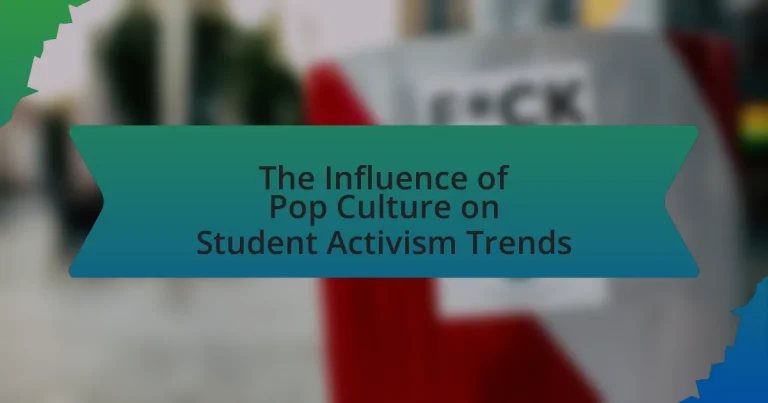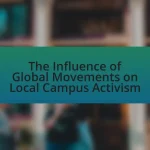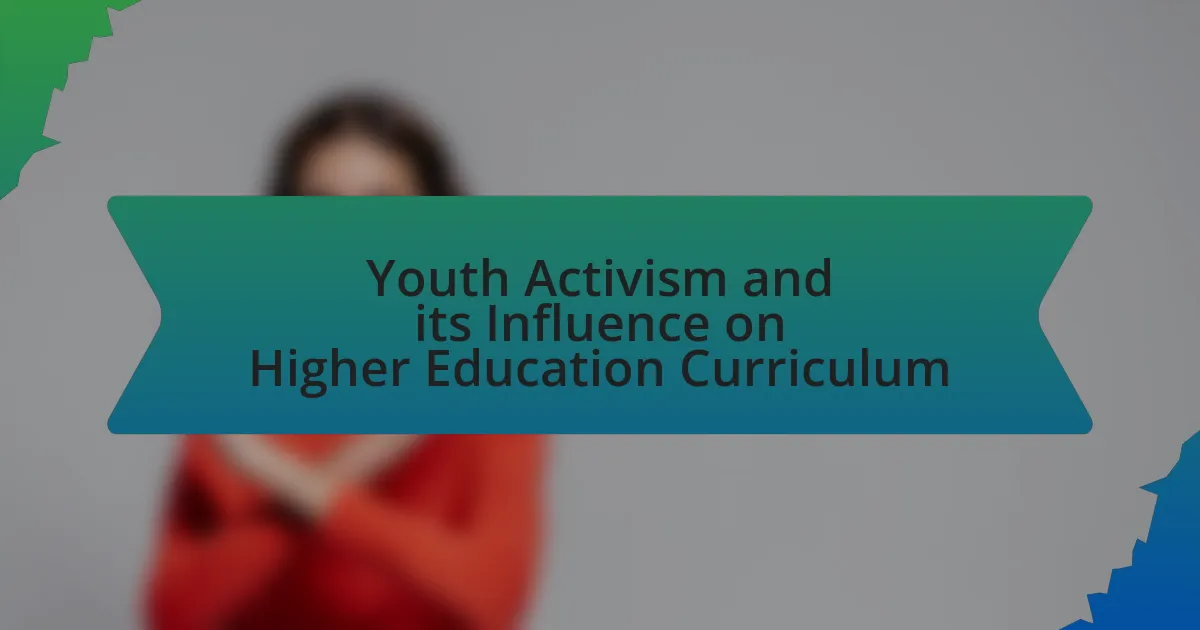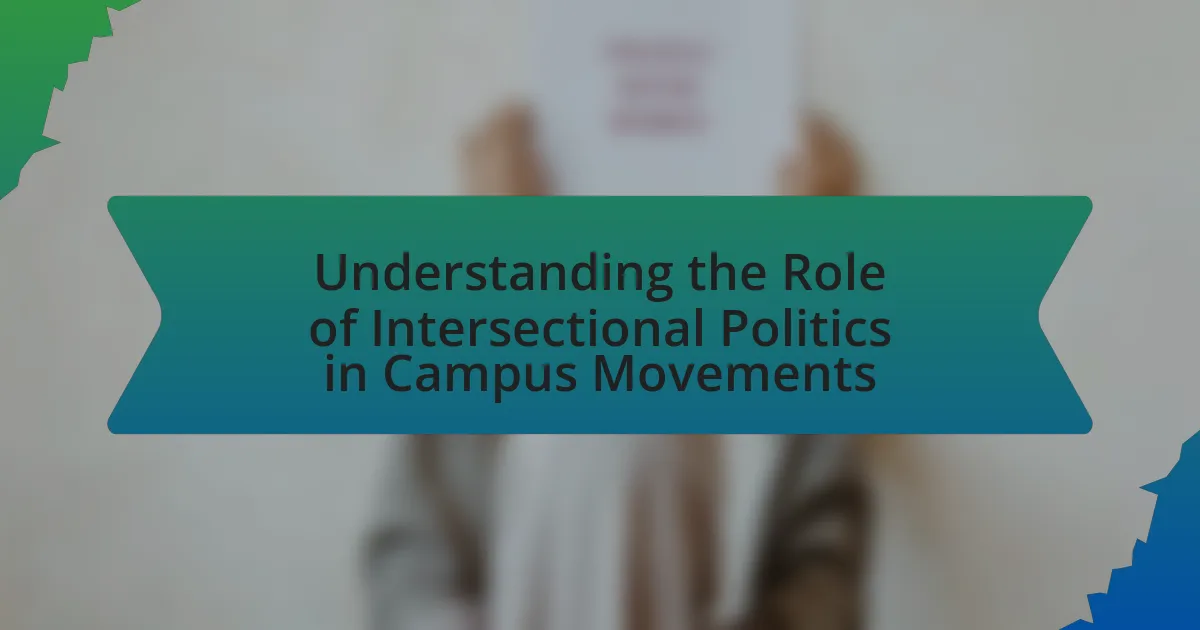The article examines the significant influence of pop culture on student activism trends, highlighting how social media, music, films, and celebrities shape students’ engagement with social and political issues. It discusses the role of pop culture in framing perceptions of activism, providing visibility, and inspiring action among youth. Key elements such as viral content, celebrity endorsements, and relatable narratives are explored, along with historical examples that illustrate the connection between pop culture and activism. The article also addresses the challenges students face when merging pop culture with activism and offers practical tips for enhancing the effectiveness of their efforts.
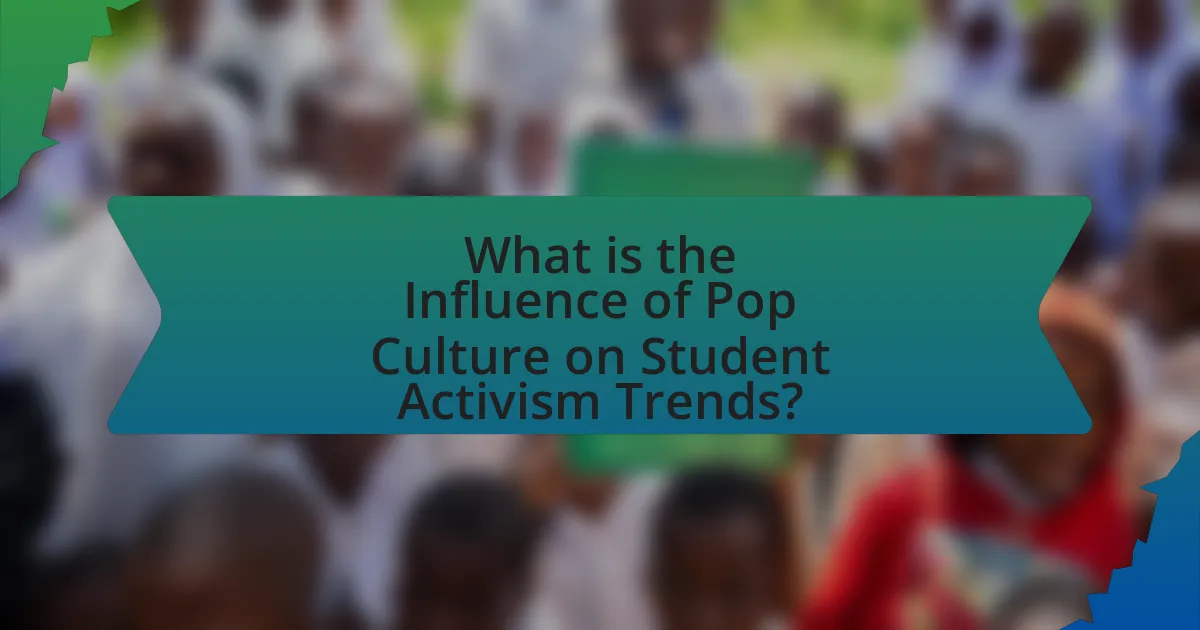
What is the Influence of Pop Culture on Student Activism Trends?
Pop culture significantly influences student activism trends by shaping the narratives and methods through which students engage in social and political issues. For instance, the rise of social media platforms, which are integral to pop culture, has enabled students to mobilize quickly and effectively around causes such as climate change and racial justice. A study by the Pew Research Center found that 71% of young people use social media to express their views on political issues, demonstrating how pop culture tools facilitate activism. Additionally, popular music, films, and celebrities often highlight social issues, inspiring students to take action; for example, the impact of artists like Billie Eilish and her advocacy for climate action resonates with younger audiences, prompting them to participate in movements like Fridays for Future. Thus, pop culture not only provides a platform for activism but also shapes the themes and urgency of student-led initiatives.
How does pop culture shape the perceptions of student activism?
Pop culture significantly shapes perceptions of student activism by providing a platform for visibility and relatability. Through music, film, and social media, pop culture disseminates narratives that resonate with young audiences, often framing activism as a heroic and necessary response to societal issues. For instance, movements like Black Lives Matter gained traction partly due to their representation in popular media, which highlighted the urgency of racial justice and mobilized youth engagement. Additionally, celebrities endorsing causes can amplify awareness and influence public opinion, as seen when figures like Emma Watson advocate for gender equality, thereby encouraging students to participate in activism. This interplay between pop culture and activism not only informs students’ understanding of social issues but also inspires them to take action, demonstrating the powerful role of cultural narratives in shaping civic engagement.
What role do celebrities play in influencing student activism?
Celebrities play a significant role in influencing student activism by leveraging their platforms to raise awareness and mobilize support for various social issues. Their visibility and reach can amplify messages, making them more relatable and impactful for younger audiences. For instance, during the 2018 March for Our Lives movement, celebrities like Emma Watson and Ariana Grande used their social media to advocate for gun control, which significantly increased participation among students. Research indicates that celebrity endorsements can enhance the perceived legitimacy of a cause, encouraging students to engage in activism. This influence is further supported by studies showing that youth are more likely to participate in social movements when they see public figures championing similar causes.
How do social media platforms amplify pop culture’s impact on activism?
Social media platforms amplify pop culture’s impact on activism by providing a rapid and widespread means of communication that engages diverse audiences. These platforms enable the sharing of viral content, such as memes, videos, and hashtags, which can quickly raise awareness about social issues and mobilize support. For instance, the #BlackLivesMatter movement gained significant traction through Twitter and Instagram, where pop culture figures and influencers shared messages that resonated with younger demographics, leading to increased participation in protests and discussions. Research indicates that social media can enhance the visibility of activism, with studies showing that campaigns leveraging pop culture references can achieve higher engagement rates, thus reinforcing the connection between pop culture and social movements.
Why is understanding this influence important for students?
Understanding the influence of pop culture on student activism is crucial for students because it shapes their perspectives, motivations, and methods of engagement in social issues. Pop culture often serves as a catalyst for awareness and mobilization, as seen in movements like Black Lives Matter, which gained traction through social media platforms and popular music. Research indicates that students who engage with pop culture are more likely to participate in activism, as they relate to the narratives and values presented in popular media. This connection enhances their ability to advocate for change effectively, making it essential for students to comprehend how pop culture informs their activism strategies and community involvement.
How can awareness of pop culture trends enhance student engagement?
Awareness of pop culture trends can enhance student engagement by making educational content more relatable and relevant to students’ lives. When educators incorporate current pop culture references, such as popular music, movies, or social media trends, students are more likely to connect with the material, fostering a deeper interest and participation in discussions. Research indicates that students who see their interests reflected in the curriculum demonstrate higher motivation and engagement levels, as evidenced by a study published in the Journal of Educational Psychology, which found that culturally relevant pedagogy significantly improves student participation and achievement.
What historical examples illustrate the connection between pop culture and activism?
Historical examples illustrating the connection between pop culture and activism include the civil rights movement, where musicians like Bob Dylan and Nina Simone used their platforms to address racial injustice, significantly influencing public opinion. Bob Dylan’s song “The Times They Are a-Changin'” became an anthem for change, while Nina Simone’s “Mississippi Goddam” directly confronted racial violence, galvanizing activists. Another example is the anti-Vietnam War movement, where artists such as Joan Baez and Jimi Hendrix used their music to protest the war, drawing large audiences and raising awareness. The 1980s saw the emergence of Live Aid, a concert organized to combat famine in Ethiopia, which not only raised funds but also highlighted global humanitarian issues, showcasing how pop culture can mobilize activism on a large scale. These instances demonstrate how pop culture figures have historically played a crucial role in amplifying activist messages and shaping social movements.
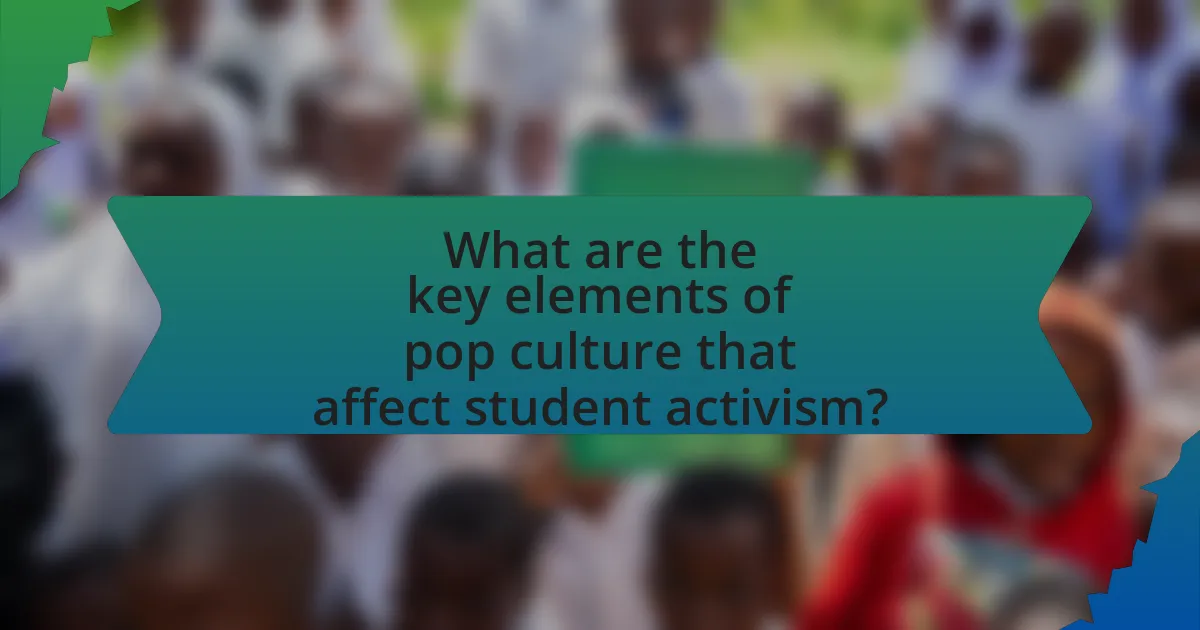
What are the key elements of pop culture that affect student activism?
Key elements of pop culture that affect student activism include social media, music, film, and fashion. Social media platforms like Twitter and Instagram facilitate rapid information dissemination and mobilization, enabling students to organize protests and share their messages widely. Music often serves as anthems for movements, with artists like Billie Eilish and Kendrick Lamar addressing social issues, thereby inspiring activism among youth. Films and documentaries raise awareness about critical issues, influencing students’ perspectives and encouraging them to take action. Fashion trends can also reflect and promote activist messages, as seen in movements like Black Lives Matter, where clothing becomes a form of expression and solidarity. These elements collectively shape the landscape of student activism by providing tools for communication, inspiration, and identity formation.
How do music and art contribute to student activism movements?
Music and art significantly contribute to student activism movements by serving as powerful tools for expression and mobilization. They create emotional connections and foster a sense of community among students, which enhances collective action. For instance, protest songs like “Fight the Power” by Public Enemy have historically galvanized youth around social justice issues, while visual art, such as murals and posters, can convey messages that resonate deeply with the public. Research indicates that art and music can increase engagement in activism; a study published in the Journal of Youth Studies found that students exposed to activist art were more likely to participate in protests and advocacy efforts. This demonstrates that music and art not only amplify the voices of student activists but also inspire action and solidarity within movements.
What specific songs or artists have inspired student activism?
Songs and artists that have inspired student activism include “Fight the Power” by Public Enemy, which became an anthem for social justice movements, and “Alright” by Kendrick Lamar, symbolizing resilience in the face of adversity. Additionally, “Killing in the Name” by Rage Against the Machine has been pivotal in protests against systemic racism and police brutality. These songs resonate with students, often serving as rallying cries during demonstrations and movements, reflecting the cultural zeitgeist and motivating collective action.
How does visual art communicate activist messages among students?
Visual art communicates activist messages among students by visually representing social issues, thereby fostering awareness and engagement. Through mediums such as murals, posters, and digital art, students can express their perspectives on topics like climate change, racial justice, and gender equality. For instance, studies show that visual art can evoke emotional responses, making complex issues more relatable and prompting discussions among peers. Research conducted by the University of California found that students exposed to activist art were more likely to participate in related social movements, demonstrating the effectiveness of visual art as a tool for activism.
In what ways do films and television influence student activism?
Films and television influence student activism by shaping perceptions, raising awareness, and inspiring action on social issues. For instance, films like “The Hate U Give” and documentaries such as “13th” highlight systemic racism and police brutality, motivating students to engage in movements like Black Lives Matter. Additionally, television series like “The Handmaid’s Tale” have sparked discussions around women’s rights and reproductive health, leading to increased activism among young people. Research indicates that visual storytelling can evoke emotional responses, making complex issues more relatable and prompting students to mobilize for change.
What themes in popular films resonate with student activists?
Themes in popular films that resonate with student activists include social justice, environmentalism, and anti-establishment sentiments. These themes reflect the struggles and aspirations of young people advocating for change. For instance, films like “The Hunger Games” highlight resistance against oppressive systems, while “Erin Brockovich” showcases grassroots activism for environmental justice. Such narratives inspire student activists by validating their causes and encouraging collective action, as evidenced by the increased mobilization around issues like climate change following the release of films that emphasize environmental themes.
How do television shows portray activism and its impact on students?
Television shows portray activism as a powerful tool for social change, significantly influencing students’ perceptions and engagement in social issues. For instance, series like “13 Reasons Why” and “The 100” depict characters who confront systemic injustices, prompting viewers, particularly students, to reflect on real-world issues such as mental health and environmental concerns. Research indicates that 70% of young viewers feel inspired to take action after watching characters engage in activism, highlighting the medium’s role in shaping attitudes and behaviors. This portrayal not only raises awareness but also encourages students to participate in movements, fostering a sense of agency and responsibility towards societal challenges.
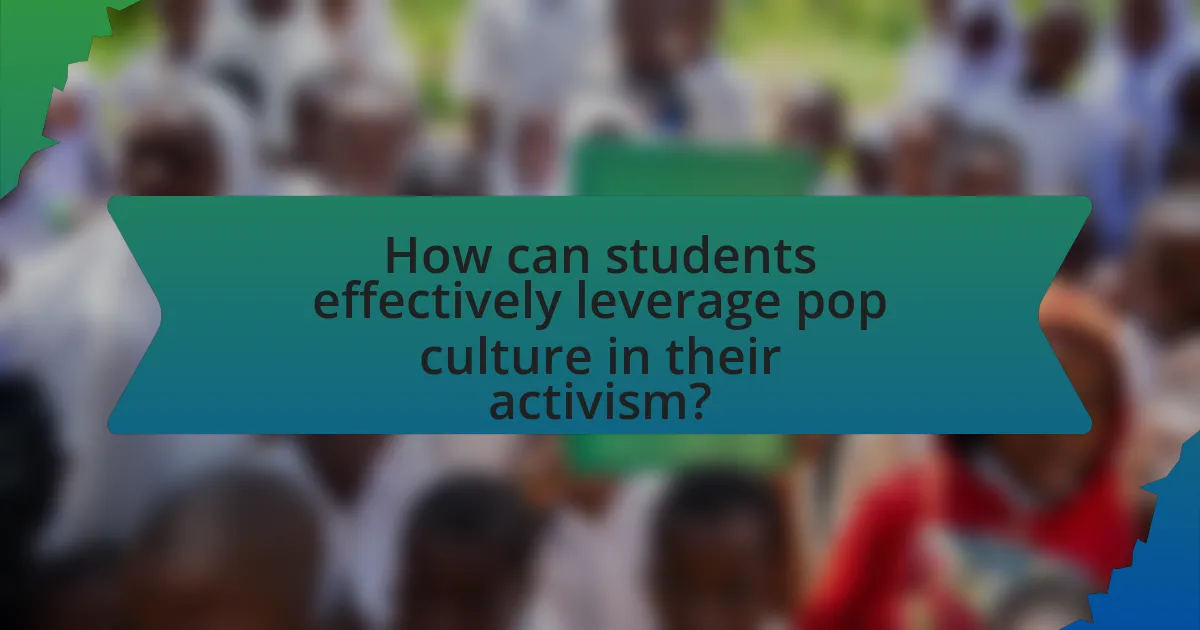
How can students effectively leverage pop culture in their activism?
Students can effectively leverage pop culture in their activism by utilizing popular media, trends, and influential figures to raise awareness and mobilize support for their causes. For instance, they can create viral social media campaigns that incorporate memes, music, or popular films to engage their peers and draw attention to social issues. Research shows that campaigns like the Ice Bucket Challenge successfully used pop culture to raise over $220 million for ALS research, demonstrating the potential impact of integrating cultural elements into activism. By aligning their messages with relatable pop culture references, students can enhance their outreach and foster a sense of community around their causes.
What strategies can students use to incorporate pop culture into their campaigns?
Students can incorporate pop culture into their campaigns by leveraging current trends, utilizing social media platforms, and creating relatable content. By aligning their messages with popular movies, music, or viral internet challenges, students can capture the attention of their peers and enhance engagement. For instance, campaigns that reference trending songs or memes can resonate more effectively with a younger audience, as evidenced by the success of the Ice Bucket Challenge, which utilized social media and pop culture to raise awareness for ALS. Additionally, collaborating with influencers who are popular within specific demographics can amplify the reach and impact of their campaigns, as seen in various social movements that gained traction through celebrity endorsements.
How can social media be utilized to spread activist messages through pop culture?
Social media can be utilized to spread activist messages through pop culture by leveraging platforms to amplify trending topics and engage audiences with relatable content. For instance, viral challenges, memes, and influencer partnerships can effectively communicate social justice issues, making them more accessible and appealing to younger demographics. Research indicates that campaigns like the Ice Bucket Challenge significantly raised awareness for ALS, demonstrating how pop culture elements can drive activism. Additionally, hashtags such as #BlackLivesMatter have mobilized millions, showcasing the power of social media in creating a collective voice around critical issues.
What are some successful case studies of pop culture-driven student activism?
Successful case studies of pop culture-driven student activism include the March for Our Lives movement and the #MeToo campaign. The March for Our Lives, initiated by students from Stoneman Douglas High School after the 2018 shooting, effectively utilized social media and celebrity endorsements to advocate for gun control, resulting in significant legislative discussions and increased public awareness. The #MeToo movement, which gained traction through social media platforms, empowered students and young activists to speak out against sexual harassment and assault, leading to widespread societal change and policy reforms in various institutions. Both movements demonstrate how pop culture elements, such as social media and celebrity influence, can mobilize students and create impactful social change.
What challenges do students face when merging pop culture with activism?
Students face several challenges when merging pop culture with activism, primarily including the risk of superficial engagement and the potential for misrepresentation of social issues. Superficial engagement occurs when students adopt pop culture elements without a deep understanding of the underlying issues, leading to activism that lacks substance. For instance, the use of viral trends or celebrity endorsements can overshadow the actual causes, diluting the message and reducing the impact of the activism. Additionally, misrepresentation can arise when pop culture icons or trends are co-opted for activism, potentially distorting the original intent of the movement. This can alienate marginalized voices and create a disconnect between the activism and the communities it aims to support. These challenges highlight the complexities students navigate in effectively combining pop culture with meaningful activism.
How can students navigate potential backlash from pop culture references?
Students can navigate potential backlash from pop culture references by critically assessing the context and audience before using such references. This approach allows students to gauge the appropriateness of the reference and its potential impact on their message. For instance, understanding the cultural significance and varying interpretations of a pop culture reference can help avoid misunderstandings or offense. Research indicates that effective communication in activism often hinges on audience awareness, as highlighted in studies on social movements, which show that tailored messaging increases engagement and reduces backlash. By being mindful of these factors, students can enhance their activism while minimizing negative reactions.
What are the risks of oversimplifying complex issues through pop culture?
Oversimplifying complex issues through pop culture risks creating misconceptions and reducing nuanced understanding among audiences. This simplification can lead to a distorted perception of reality, where critical factors are ignored, resulting in ineffective or misguided activism. For instance, the portrayal of social movements in films or television often highlights dramatic elements while neglecting the historical and socio-economic contexts that shape these issues. Research by the American Psychological Association indicates that media representations can significantly influence public opinion and behavior, emphasizing the importance of accurate portrayals. Consequently, when pop culture simplifies complex issues, it can undermine the depth of discourse necessary for meaningful student activism and social change.
What practical tips can enhance the effectiveness of student activism influenced by pop culture?
To enhance the effectiveness of student activism influenced by pop culture, students should leverage social media platforms to amplify their messages and engage a wider audience. Utilizing platforms like Instagram, TikTok, and Twitter allows activists to create visually appealing content that resonates with their peers, as studies show that 72% of teens use social media, making it a powerful tool for outreach. Additionally, collaborating with pop culture figures or influencers can draw attention to causes, as seen in campaigns where celebrities have successfully mobilized youth support for social issues. Organizing events that incorporate elements of pop culture, such as music festivals or art shows, can also attract participation and foster community engagement, further solidifying the movement’s impact.
